 Radio Stories from Nashville
Radio Stories from Nashville
WSM Radio - The Birth of The Grand Ole Opry - DeFord Bailey "The Harmonica Wizard"
Produced by The Kitchen Sisters (Nikki Silva & Davia Nelson) with Laura Folger
Mixed by Jim McKee at Earwax Productions, San Francisco
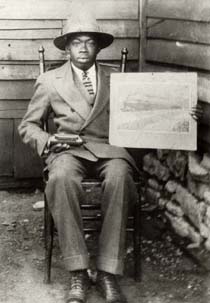
Young DeFord shown holding a photo of the Pan American Express train in one hand, his harmonica in the other.
Courtesy of David Morton
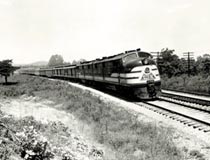
Pan American Express Train.
Courtesy of David Morton
|
Listen in RealAudio:
28.8 or
G2 flavors.
More about the Hatch Show Print.
More about Radio Station WSM.
Read a discography of music related to this feature.
Read a listing of collaborators and resources.
Back to main story page.
DEFORD BAILEY
excerpts from an interview with David Morton
" …He was fascinated with trains since he was a kid. He had heard them on the radio. He was out on a farm and you could hear the train at a distance. He was listening to every sound he could at night, and he'd hear that train every night at it came through. As he went to school, he would even go and pass under a train trestle. And he and his sisters would get up and listen. And they'd wait to let the train go over so that they could actually hear all the sounds and see the, the smoke and the cinders and every - the whole thing. The whole experience. Then he said he'd close his eyes and, and listen to the train as it came over. So he was fascinated with trains since he was a kid. He developed a very unique rendition of the train that conveyed all the sounds and did it, as he said, in a way that it was moving all the time. I mean, it wasn't just standing still. It was constantly going forward.
"…He latched onto that harmonica. It stirred his imagination and he used that instead of toys, like other kids would have had today, he was there playing with his harmonica and needless to say, there were some other instruments that they tried to give him two things to occupy his time. But even at that early age, he latched onto the harmonica."
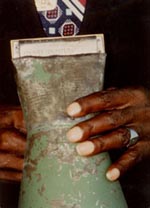
DeFord holding his metal megaphone that he had made with his harmonica placed in it.
Photo courtesy of David Morton
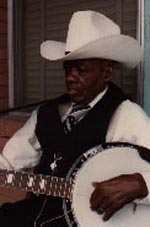
DeFord at his home, Gernert Homes Apartment Complex, Nashville 1975 - strummin on the banjo.
|
"…Bailey frequently used a megaphone to project with his microphone. He had two or three different megaphones he used. One was a fairly professional one. One was sort of hand made one - and then he had a gourd that he actually had used as a, a megaphone, so to speak. "
"...he would do different things. He'd put a different kind of whistle on the train than it really had because he liked the whistle. And so he was a little bit creative at times with his trains, but they were one of his most loved expressions of music was the train. As he said, he worked years perfecting it. Of course he was always wanting to improve it. Whatever he could do to make it better, he tried to do…"
"…DeFord Bailey was a very short man. He was 4'11". When I knew him, he had very little hair, at this point. He had lost most of his hair. He had very smooth skin. He had a very beautiful smile. When he smiled, you-you just... you were very warm when you were with him and he was smiling. He always dressed, even in his apartment, as if he were ready to perform. He never looked casual or would wear. He was always dressed - even if he didn't go outside his door - he was dressed as if he were going to a performance. "
He has a bowler hat, that's - white hat with a black bow around it that's just really classy. And again, if you could see the shoes, you would see them glistening… "
"…I walk into this apartment and I'm greeted at the door by this little man in an absolutely impeccable suit, shoes are shining like diamonds. He is...just an incredible gentleman - pleasant smile. You look around the apartment and it's like you're in a museum. He has memorabilia from his years on the Opry, from his years of music on the walls - crowded! I mean, you could - you had to walk around things to get through the apartment. But everything had significance."
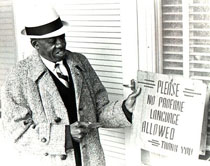
1970, Deford in front of his shoe shine shop in Edgehill
Photo by Archie Allen, courtesy of David Morton
|
"..And after he went on the Opry, he was still always looking for ways to make some extra money and, and take care of his family. After he left the Opry, is when he really set up a fairly permanent shoe shine shop.
At that point, he was well known. People loved to hear him, so there were people that would come to get their shoe shined, just to be able to hear him play a tune. So he did a pretty good business, actually, in the 50s and 60s with his shoe shine shop. And he would have a variety of, of kids working for him shining shoes. "
"..We had the dedication ceremony for the monument on DeFord's grave, we had almost all the Grand Ole Opry performers who were still alive, who had performed with him, along with the Mayor of Nashville and family and ministers and a whole lot of people who wanted to celebrate that occasion. And we couldn't do that without having a lot of music. It was obviously important to us that we have an opportunity to memorialize Mr. Bailey. And to celebrate his music - so we had a number of people who played at the ceremony, but one of the songs that really was very special at that ceremony was having Bill Monroe play the Evening Prayer Blues, which was the tune that DeFord had created of one of his ministers actually leading his congregation in prayer. ".
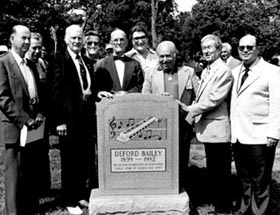 | Memorial gathering for DeFord, June 23,1983,
Greenwood Cemetary, Nashville, TN
Kirk McGee, Bill Monroe & Herman Crook
Zeke Clement and Roy Acuff with Uncle Davie Macon's Grandson |
You need the free RealAudio player to listen to audio files.
Copyright © 2000 The Kitchen Sisters
|

